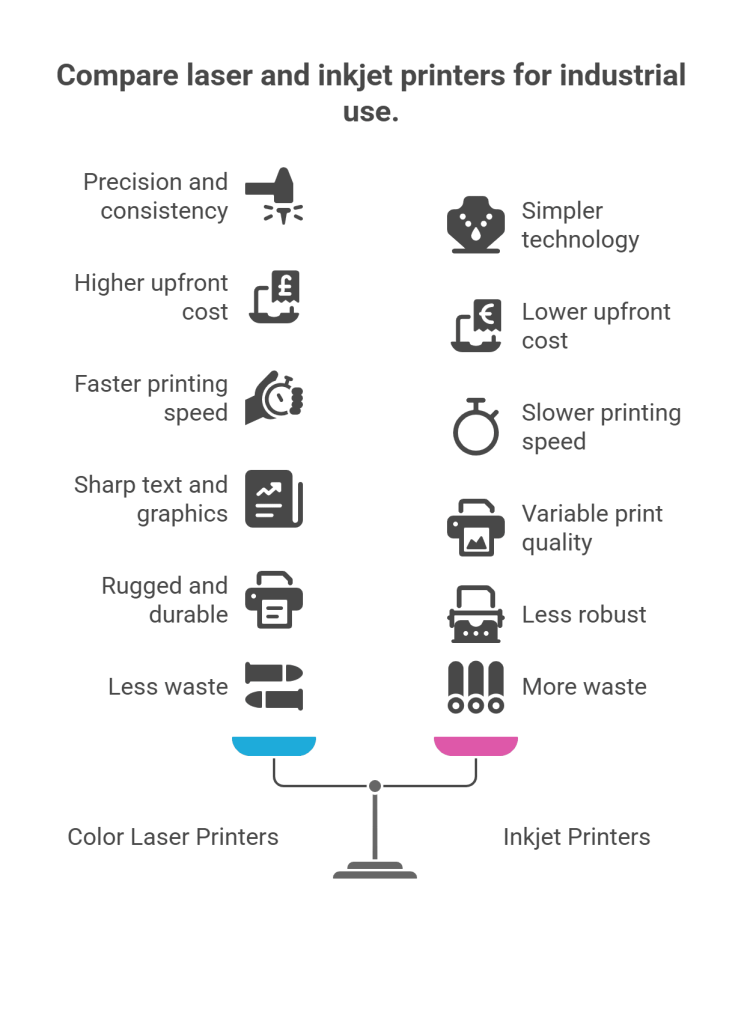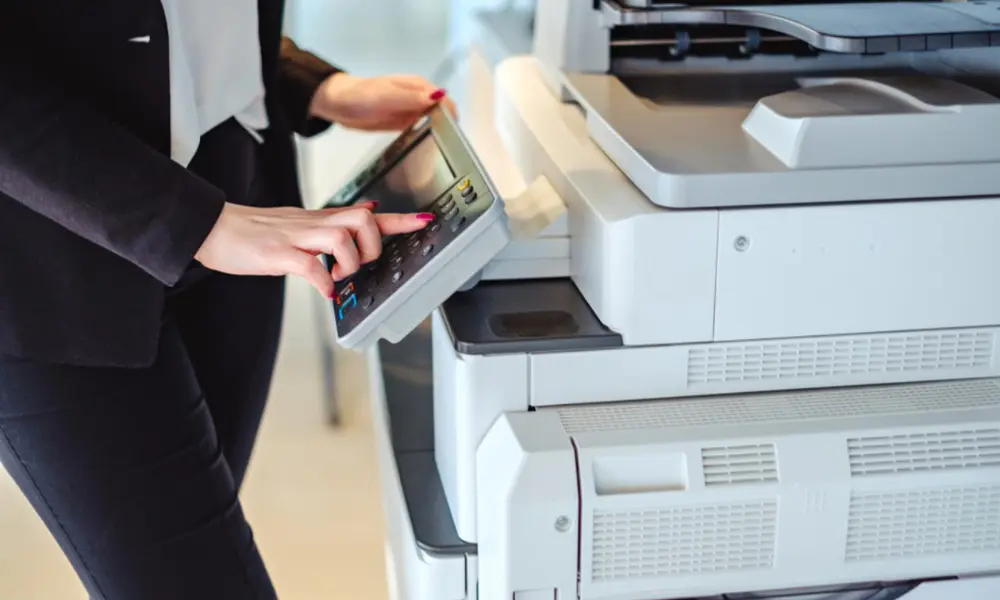Color laser printer Vs. Inkjet – which is better for your business. You are not the first person to ask this question. Many get confused over the different types of printers and fail to understand which printer will suit their needs. Fret not, we have you covered.
This article will be your ultimate guide to selecting the best printer for your business needs. Let’s explore the printer industry in detail.
Let’s begin with clearing the misconception of inkjet and laser printers and unravel the basics.

What is an Inkjet Printer?
An inkjet printer is a type of printer that creates images or text on paper by propelling tiny droplets of liquid ink onto the paper. These printers are known for their versatility and ability to produce high-quality color prints. Here’s how they work:
1) Ink Cartridges: Inkjet printers use ink cartridges that contain one or more ink reservoirs. These cartridges typically include separate tanks for different ink colors, such as cyan, magenta, yellow, and black (CMYK).
2) Printing Process: When a print job is initiated, the printer’s internal mechanism moves a print head across the paper. The print head contains hundreds of tiny nozzles that spray the ink droplets onto the paper. The ink is released from the nozzles in a controlled manner.
3) Controlled Droplets: The printer’s software precisely controls the formation and placement of ink droplets on the paper. By varying the size and placement of these droplets, the printer can recreate the desired image or text.
4) Color Mixing: By overlapping and combining tiny droplets of different ink colors, inkjet printers are capable of creating a wide range of colors and producing high-quality, photo-realistic images.
5) Paper Types: Inkjet printers are versatile and can print on various types of paper, including plain paper, glossy photo paper, and specialty media, making them suitable for a wide range of applications.
Inkjet printers are commonly used for home and office purposes, as well as in graphics and photo printing where color accuracy and high-resolution output are essential.
What is Color Laser Printer?
A color laser printer is a type of printer that uses a combination of static electricity, heat, and toner (a fine powder) to create images or text on paper. How color laser printer work? These printers are known for their speed, precision, and suitability for high-volume printing. Here’s how they work:
1) Electrophotographic Process:
The key technology used in laser printers is the electrophotographic process, also known as laser printing. This process involves several steps:
- Charging: A photosensitive drum inside the printer is charged with static electricity by a corona wire or roller. This charge creates an electrostatic image of the page to be printed.
- Exposure: A laser beam, controlled by the printer’s software, is used to draw the image or text onto the charged drum. The laser selectively discharges the electrostatic charge on the drum, creating a pattern of the desired image or text.
- Developing: Toner, which is a fine, dry powder made of pigments and plastic, is applied to the drum. The toner is attracted to the areas where the electrostatic charge remains.
- Transfer: The toner image on the drum is transferred onto the paper. The paper is given a positive charge, which attracts the negatively charged toner from the drum.
- Fusing: The toner on the paper is fused or melted onto the paper’s surface using heat and pressure in the fuser unit, resulting in a permanent image.
2) Speed and Precision:
Laser printers are known for their speed and precision. They can produce a large number of pages per minute (PPM) and are highly reliable, making them ideal for office and industrial use. The best color laser printer is the one that suits your specific requirements.
Next, let’s settle the long debate of color laser printers vs. inkjet once and for all.
Color Laser Printer vs. Inkjet: A Clash of Technologies

1) Technology
The fundamental difference between color laser printers and inkjet printers lies in their underlying technology. Color laser printers use a combination of static electricity, heat, and toner to create images on paper. In contrast, inkjet printers use liquid ink that is sprayed onto the paper.
Color laser printers use a process called electrophotography, more commonly known as laser printing. They rely on a laser beam to draw an electrostatic image on a drum, which then attracts toner particles to form the image. This process is known for its precision and consistency.
Inkjet printers, on the other hand, disperse tiny droplets of liquid ink onto the paper. The quality and precision of the image largely depend on the resolution of the printer and the type of ink used.
2) Cost
When it comes to industrial purposes, cost considerations are paramount. In the color laser printer vs. inkjet debate, cost plays a significant role.
- Color Laser Printers: Laser printers are typically more expensive upfront. They require precision components, including a laser assembly, drum unit, and fuser, which contribute to their higher initial cost. However, over time, the cost per page for laser printers is often lower due to the efficiency of toner cartridges.
- Inkjet Printers: Inkjet printers are generally more affordable upfront. The technology is simpler, and the printers themselves are less complex. However, the cost of inkjet ink cartridges can add up over time, especially in high-volume printing environments.
3) Speed
Industrial settings demand high printing speeds to maintain productivity. Let’s compare the speed of color laser printers and inkjet printers.
- Color Laser Printers: Laser printers are known for their speed, making them ideal for high-volume printing. They can produce a large number of pages per minute (PPM), which is crucial in industrial settings where time is of the essence.
- Inkjet Printers: Inkjet printers tend to be slower in comparison. While advancements in technology have improved print speeds, they are generally not as fast as laser printers. This could be a limiting factor in industrial applications with high-output requirements.
4) Print Quality
The quality of the prints is a key consideration, especially for applications that demand precision and clarity.
- Color Laser Printers: Laser printers excel in producing sharp and consistent text and graphics. The toner provides a professional finish with clean lines and vibrant colors. This makes them ideal for tasks such as marketing collateral and high-quality document printing.
- Inkjet Printers: Inkjet printers can also produce high-quality prints, particularly when using specialized photo ink. However, their quality can vary depending on the paper type and ink quality. In industrial applications, where consistent results are essential, this variability may be a concern.
5) Durability
Industrial printers need to withstand heavy use and are expected to have a longer lifespan. Let’s compare the durability of color laser printers and inkjet printers.
- Color Laser Printers: Laser printers are built to be rugged and durable. Their components are designed to handle large print volumes, and they are less prone to breakdowns. This makes them a reliable choice for industrial applications.
- Inkjet Printers: While inkjet printers have improved in terms of durability, they are generally considered less robust than laser printers. Frequent use can lead to wear and tear on components, potentially resulting in maintenance issues.
6) Environmental Impact
In today’s eco-conscious world, environmental considerations play a significant role in decision-making. Let’s evaluate the environmental impact of color laser printers and inkjet printers.
- Color Laser Printers: Laser printers use toner cartridges, which generate less waste compared to inkjet cartridges. However, the toner itself can contain chemicals that are harmful to the environment. It’s important to recycle toner cartridges properly to mitigate their environmental impact.
- Inkjet Printers: Inkjet printers are considered more environmentally friendly due to their use of liquid ink. However, the disposal of plastic ink cartridges remains an issue. Some inkjet printers use eco-friendly ink formulations, further reducing their environmental impact.
Conclusion
In the color laser printer vs. inkjet debate for industrial purposes, there is no one-size-fits-all answer. Your choice should depend on your specific needs, budget, and preferences. Color laser printers offer speed, durability, and consistent quality but may come with a higher upfront cost. Inkjet printers are more cost-effective initially and can produce high-quality prints, but they may not match the speed and durability of laser printers.
If you are looking for the best industrial printers for your business, get in touch with Qodenext for a detailed guide on the best printers available in the market.
Also read: Deskjet Vs. Inkjet Printer: Which is Best for Industrial Purposes?
Now, let’s address the commonly asked questions about a color laser printer vs. inkjet.
FAQs- Color Laser Printer Vs. Inkjet
1. Which printer is better, laser or inkjet?
Choosing between a laser or inkjet printer depends on your printing needs. Laser printers usually have a higher upfront cost but offer a lower cost per page, making them ideal for high-volume text printing. Inkjet printers are cheaper initially and better for producing vibrant, high-quality images but can get costly over time if you print a lot.
2. What are the main disadvantages of a laser printer?
While laser printers are fast and efficient, they do take some time to warm up before printing. They often have a higher upfront price and sometimes face issues like toner leaks. Additionally, laser printers are less versatile in terms of printing on different materials or specialty papers.
3. How long does laser toner last?
Laser toner doesn’t really expire like ink in inkjet cartridges. You can keep it as long as you want, but once the toner runs out, you’ll need to replace the cartridge to keep printing without interruptions.
4. Which printer is better suited for home use: laser or inkjet?
It depends on what you print most. If your primary need is black-and-white documents or text-heavy printing, a laser printer is a great choice. But if you want to print high-quality photos or colorful graphics occasionally, an inkjet printer is usually better for home use.
5. How durable are color laser printers compared to inkjet printers for industrial use?
Color laser printers are generally more durable and built to handle heavy, continuous use, making them ideal for industrial settings. Inkjet printers tend to be less rugged and might require more frequent maintenance in demanding environments.
6. Are laser printers faster than inkjet printers?
Yes, laser printers are typically much faster, producing more pages per minute, which is important in offices or industrial environments where large volumes of printing are common. Inkjet printers are usually slower but have improved in speed over time.
7. Which type of printer produces better image quality: laser or inkjet?
Inkjet printers usually produce better-quality images and photos with more vibrant colors due to their liquid ink technology. Laser printers excel at sharp, clear text and graphics but may not always match the photo-realistic quality of inkjets.
8. Do laser printers cost more to maintain than inkjet printers?
Laser printers might have a higher initial cost, but their maintenance—especially the cost per printed page—is often lower than inkjet printers because toner cartridges tend to last longer than ink cartridges. However, replacement parts like drums or rollers can add to costs.
9. How environmentally friendly are laser and inkjet printers?
Inkjet printers generally have less environmental impact regarding chemical waste since they use liquid ink, but the plastic cartridges still pose disposal challenges. Laser printers generate less waste because toner cartridges last longer but contain chemicals that should be recycled properly to avoid environmental harm.
10. Can I use a color laser printer for photo printing?
While color laser printers can handle color images quite well for documents, they usually don’t match the rich, detailed photo quality inkjet printers provide, especially for high-resolution photos on glossy paper. For professional photo printing, inkjets are typically preferred.







